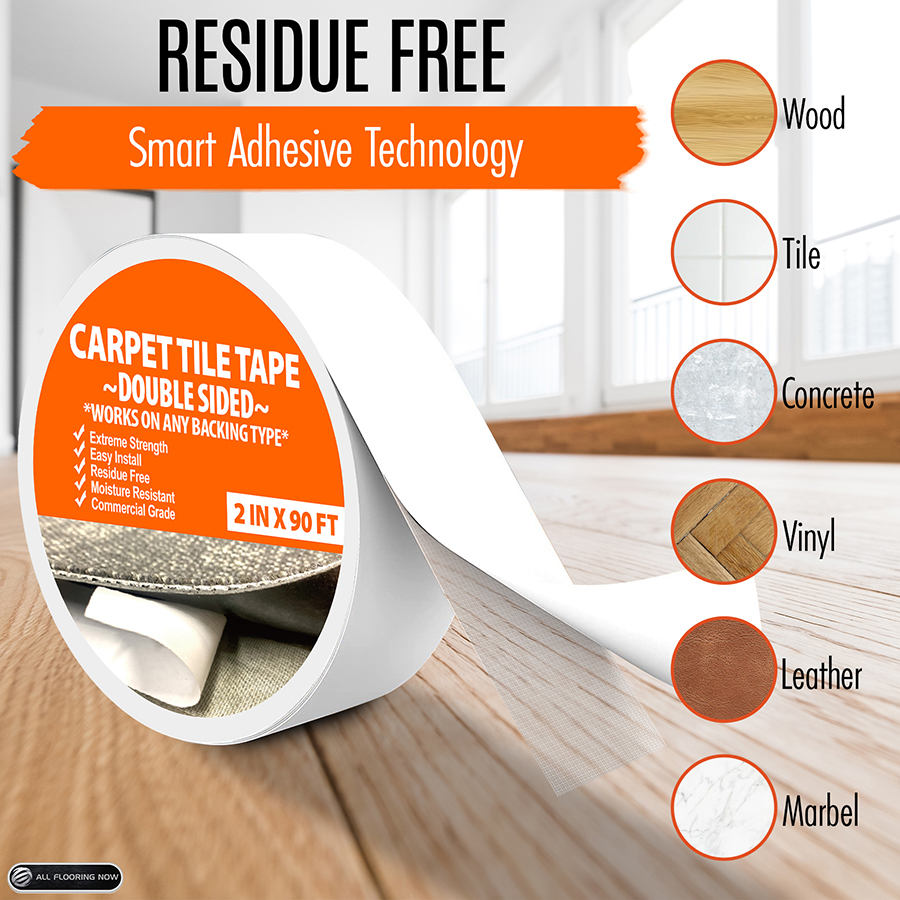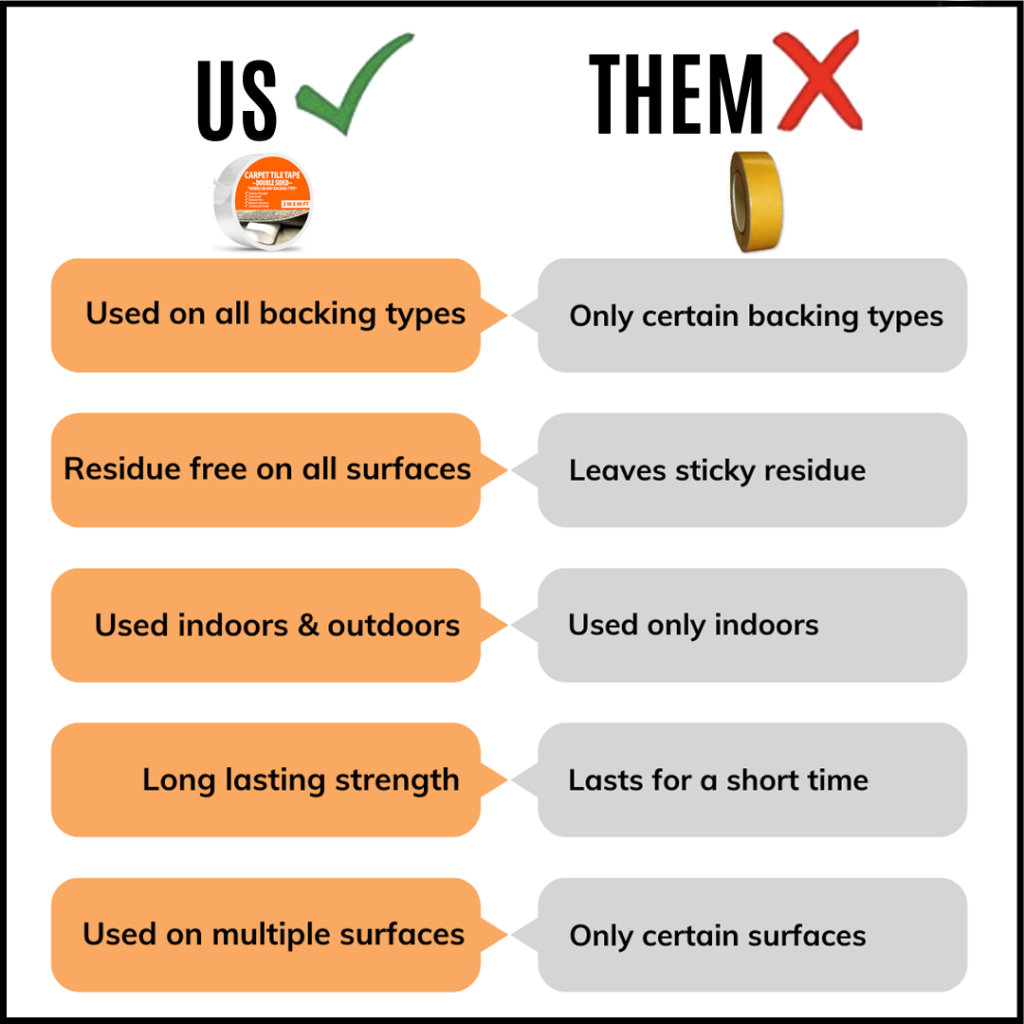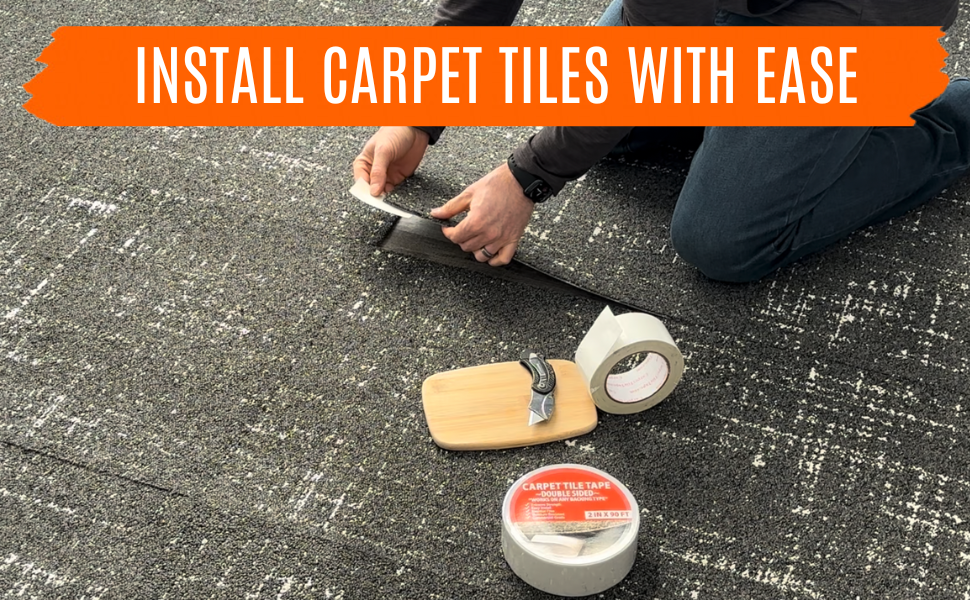What is the Best Way to Stick Carpet Tiles?
There are several methods available for sticking carpet tiles to the subfloor, each with its own set of advantages and disadvantages. Let’s explore the most popular techniques and when to use them:
1. Double-Sided Carpet Tape - Carpet Tile Tape
Best For: Temporary installations, DIY projects, small areas, or rented spaces.
Carpet Tile Tape offers a balance between ease of installation and security. It is a strong adhesive tape that sticks to both the subfloor and the carpet tiles, holding them in place without the permanence of glue.
How It Works:
- The tape is applied to the edges or corners of each carpet tile or along the perimeter of the room.
- Once the tape is in place, the protective backing is removed, and the tiles are pressed down onto the subfloor.
Advantages:
- Simple Installation: Double-sided carpet tape is easy to use and doesn’t require any special tools or adhesives.
- Non-Permanent: This method allows for easy removal and repositioning of the tiles, making it a great option for rented spaces or temporary installations.
- No Mess: Since it’s tape rather than liquid adhesive, there’s minimal risk of mess or spill during installation.
Disadvantages:
- Less Secure than Glue: While double-sided tape provides a decent bond, it may not be as secure as traditional glue, especially in high-traffic areas.
- Not Ideal for Large Areas: Using carpet tape for large installations can become cumbersome and less cost-effective compared to other methods.
Best Practices:
- Clean and dry the subfloor before applying the tape to ensure the best adhesion.
- Use high-quality carpet tape designed for flooring applications to ensure durability.
- For better security, apply tape to the perimeter of each tile rather than just the edges.
2. Peel-and-Stick Carpet Tiles
Best For: Small areas, DIY projects, residential spaces.
Peel-and-stick carpet tiles are one of the easiest and most convenient options available. These tiles come with an adhesive backing covered by a protective film. To install them, you simply peel off the film and press the tiles directly onto the floor.
How It Works:
- The adhesive is already applied to the back of the tile.
- After cleaning and preparing the subfloor, remove the protective layer and place the tile in its desired position.
- Press down firmly to ensure the tile adheres securely to the subfloor.
Advantages:
- Easy and Quick Installation: Peel-and-stick carpet tiles are extremely easy to install, making them an ideal option for beginners or DIY projects.
- No Additional Materials Needed: The adhesive is already included with the tile, so you don’t need to purchase extra glue or tape.
- Minimal Mess: Since the adhesive is pre-applied, there’s no risk of creating a mess with liquid glue or other bonding agents.
Disadvantages:
- Limited to Certain Subfloors: Peel-and-stick tiles adhere best to smooth, flat surfaces like concrete, vinyl, or plywood. If the subfloor is uneven or textured, the adhesive may not hold as securely.
- Harder to Reposition: Once pressed into place, it can be difficult to reposition the tiles without damaging the adhesive.
Best Practices:
- Ensure the subfloor is clean and free of dust, dirt, and debris before laying the tiles.
- For high-traffic areas, consider reinforcing the installation with additional adhesive in the corners or edges of the tiles.
3. Pressure Sensitive Adhesive (Tackifier Adhesive)
Best For: Semi-permanent installations, offices, or commercial spaces where tiles may need to be replaced periodically.
Tackifier adhesive is a pressure-sensitive adhesive often used in commercial settings where carpet tiles need to be installed securely but also remain easy to lift and replace when necessary. Unlike traditional glue, tackifier doesn’t form a permanent bond.
How It Works:
- The pressure sensitive adhesive is applied to the subfloor, creating a slightly sticky surface.
- Once the adhesive dries to a tacky finish, the carpet tiles are laid down. They will stick firmly but can be lifted and repositioned as needed.
Advantages:
- Easy to Replace Tiles: Tackifier provides a secure hold while allowing individual tiles to be easily lifted and replaced if they become damaged or worn.
- Long-Lasting Bond: The adhesive remains tacky over time, ensuring that the tiles stay in place without the need for reapplication.
- No Permanent Damage to Subfloor: Unlike glue, tackifier adhesive doesn’t cause damage to the subfloor, making it ideal for installations where flexibility is needed. It will leave a sticky residue on the floor which can be an issue if you need to remove.
Disadvantages:
- Not Ideal for High Traffic Areas: While tackifier adhesive is strong, it may not be suitable for areas with very heavy foot traffic, where a stronger bond is necessary.
- Requires Time to Set: Like traditional glue, tackifier needs time to dry and become tacky before you can lay the tiles.
Best Practices:
- Allow the tackifier to dry completely to a tacky finish before placing the tiles.
- Use this method in spaces where you anticipate needing to replace tiles periodically, such as offices or classrooms.
4. Carpet Tile Tabs
Carpet tile tabs are an innovative solution that offer several advantages when installing carpet tiles. Here's why they are considered a good option for carpet tile installation:
How Carpet Tile Tabs Work
Carpet tile tabs are small adhesive squares or strips that are placed at the corners or edges of carpet tiles to hold them in place. The process works as follows:
- Clean and prepare the subfloor surface.
- Lay out the carpet tiles in the desired pattern without adhesive.
- Place tabs at the corners where four tiles meet, with a portion of the tab under each tile.
- Press down firmly on the tiles to ensure good contact with the tabs.
- Continue this process across the entire installation area.
Advantages of Carpet Tile Tabs
- Easy Installation: Tabs simplify the installation process, making it accessible for DIY projects.
- Flexibility: Tiles can be easily lifted and repositioned if needed, allowing for pattern adjustments or future changes.
- No Messy Adhesives: Tabs eliminate the need for spreading adhesive across the entire floor, resulting in a cleaner installation process.
- Improved Indoor Air Quality: Unlike some adhesives, tabs typically don't emit volatile organic compounds (VOCs).
- Simple Maintenance: Individual tiles can be easily removed and replaced if damaged or worn.
- Subfloor Protection: The floating floor system created by tabs doesn't permanently adhere to the subfloor, preserving its condition.
- Cost-Effective: While initial costs may be comparable to adhesives, the ease of installation and maintenance can lead to long-term savings.
Disadvantages of Carpet Tile Tabs
- Limited Stability: In high-traffic areas, tiles may shift more easily compared to full-spread adhesive installations.
- Potential for Gaps: Without careful installation, gaps may appear between tiles over time.
- Not Suitable for All Environments: Tabs may not be recommended for areas with heavy rolling loads or extreme temperature fluctuations.
- Possible Moisture Issues: In damp environments, the lack of full-spread adhesive might allow moisture to accumulate under the tiles.
- Limited to Certain Tile Types: Not all carpet tile types may be compatible with tab installation methods.
Carpet tile tabs offer a balance of convenience and flexibility, making them an attractive option for many installations. However, it's important to consider the specific requirements of your space and the type of carpet tiles you're using when deciding between tabs and traditional adhesive methods.
Cost-Effective Solution
While the initial cost of carpet tile tabs may be comparable to adhesives, the long-term savings can be significant. The ease of installation, maintenance, and replacement can reduce overall labor costs throughout the life of the flooring.By offering a combination of ease of use, flexibility, and long-term benefits, carpet tile tabs have become an increasingly popular choice for both commercial and residential carpet tile installations. They provide a practical solution that addresses many of the challenges associated with traditional carpet tile installation methods.
Choosing the Right Method for Your Space
The best way to stick carpet tiles depends largely on the type of space you’re working in, the level of foot traffic, and your long-term goals for the flooring. Here are some factors to consider:
- For Small DIY Projects or Residential Spaces: Peel-and-stick tiles, carpet tile tape or carpet tile tabs are often the easiest and most convenient options. They’re mess-free and quick to install, making them perfect for home offices, bedrooms, or living rooms.
- For High-Traffic or Commercial Areas: Pressure sensitive adhesive is the most secure method. It provides a long-lasting, durable bond that ensures the carpet tiles stay in place, even in spaces like hallways, lobbies, or offices with heavy foot traffic.
- For Temporary or Rented Spaces: If you need an installation that is easy to remove without damaging the subfloor, carpet tile tape or carpet tile tabs are your best choice. These methods allow you to lift and replace the tiles as needed without leaving behind adhesive residue.






